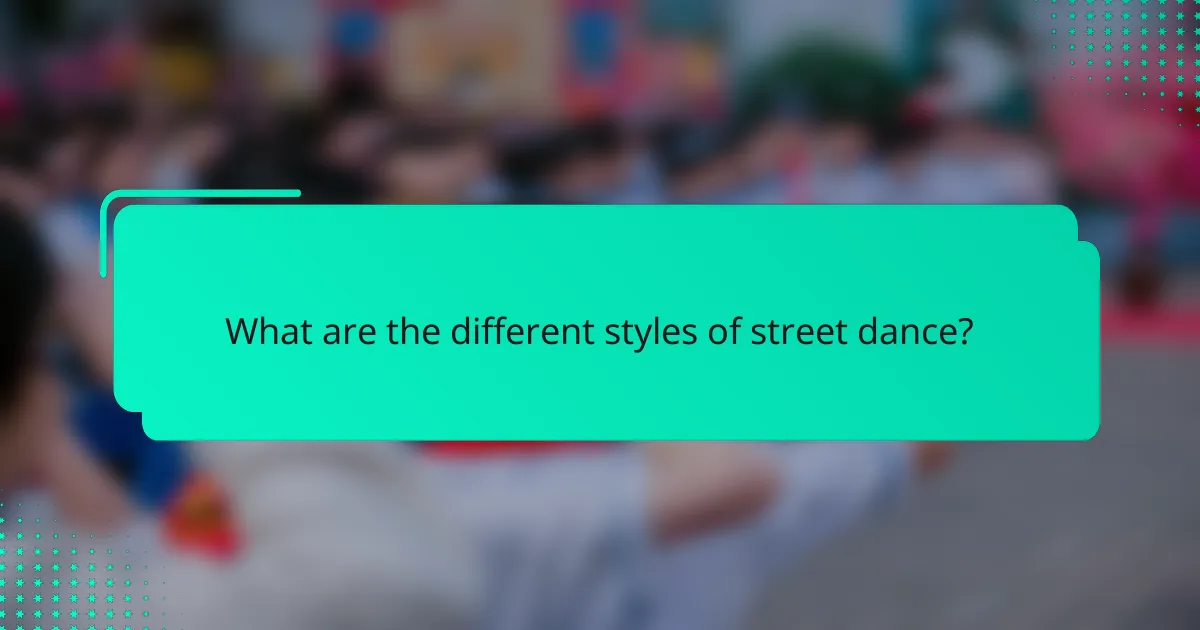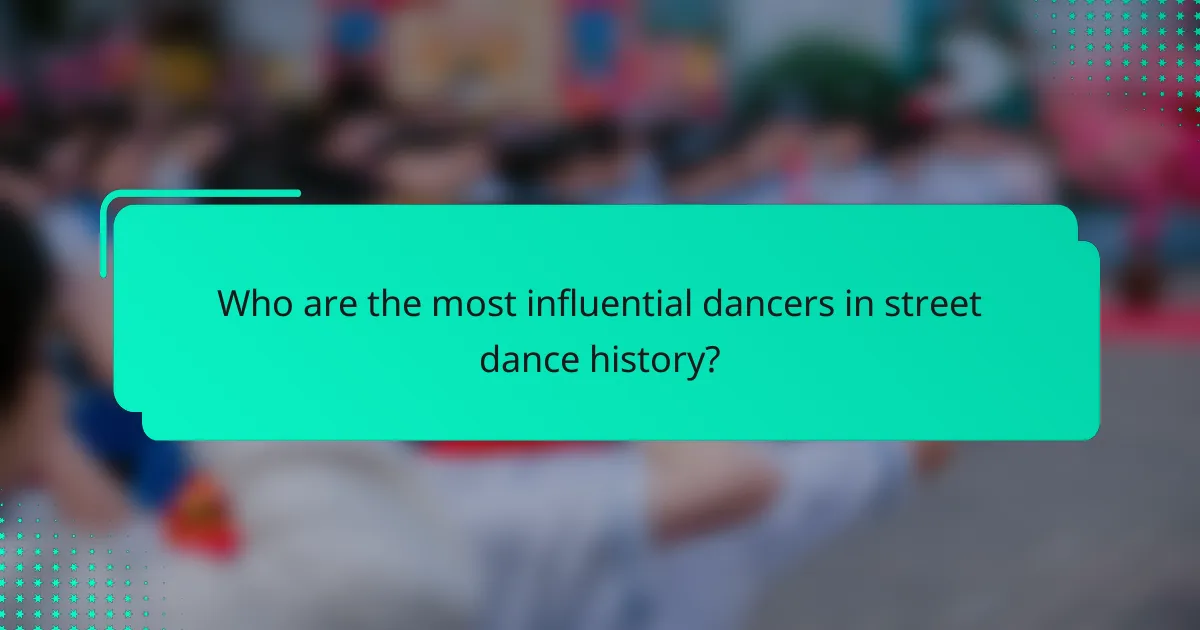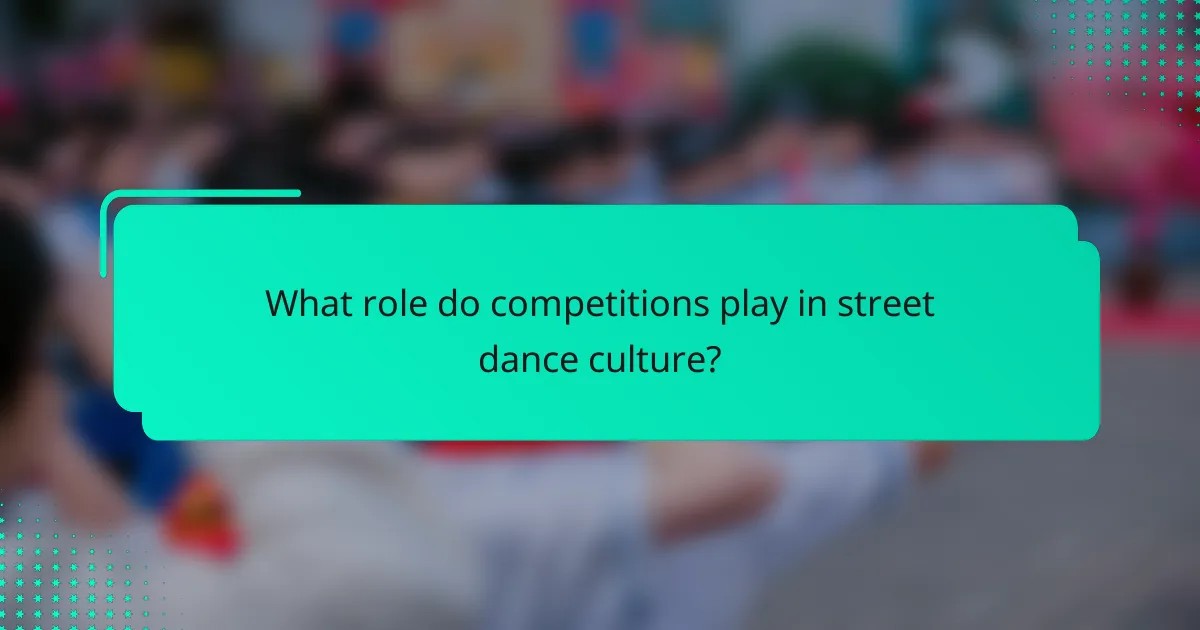Street dance encompasses various styles, including breaking, locking, popping, krumping, and turfing, each with distinct movements and cultural significance. The evolution of street dance is marked by influential figures such as Kool Herc, who pioneered hip-hop dance, and Don Campbell, the creator of locking. Competitions like the Battle of the Year and Red Bull BC One are integral to street dance culture, providing platforms for skill demonstration, community engagement, and the evolution of dance styles. This article explores the diverse styles of street dance, the contributions of key dancers, and the impact of competitive events on the dance community.

What are the different styles of street dance?
The different styles of street dance include breaking, locking, and popping. Breaking, also known as breakdancing, originated in the 1970s and involves acrobatic moves and spins. Locking features distinct, exaggerated movements and freezes, created by Don Campbell in the late 1960s. Popping is characterized by quick contractions and relaxations of muscles to create a jerking effect, developed in the 1970s by the Electric Boogaloos. Other styles include krumping, which emphasizes expressive, aggressive movements, and turfing, known for its illusionary footwork and fluid body movements. Each style has unique characteristics and cultural significance within the street dance community.
How did street dance styles originate?
Street dance styles originated in urban environments, primarily in the United States during the late 20th century. These styles emerged as a form of self-expression among marginalized communities. Influences came from various cultural backgrounds, including African American, Latino, and breakdancing traditions. Street dance was often performed in public spaces like streets, parks, and clubs. The rise of hip-hop culture in the 1970s significantly contributed to the popularity of these dance forms. Dancers sought to showcase their individuality and creativity through improvisation and unique movements. Events like block parties and dance battles further fueled the development and recognition of street dance styles.
What cultural influences shaped the evolution of street dance?
Street dance evolved through various cultural influences including hip-hop, funk, and breakdancing. Hip-hop culture, originating in the 1970s in the Bronx, was pivotal. It combined music, fashion, and art, creating a vibrant scene for street dance. Funk music and its associated dance styles, such as locking and popping, also played a crucial role. These styles infused rhythm and creativity into street dance. Additionally, the influence of African and Latin dance traditions enriched the movement vocabulary. Events like dance battles and block parties fostered community and competition. These elements collectively shaped the dynamic landscape of street dance.
What are the key milestones in the history of street dance styles?
Street dance styles have evolved through several key milestones. In the 1970s, the birth of hip-hop culture in the Bronx marked a significant beginning. This era introduced breakdancing, characterized by its acrobatic moves and battles. The 1980s saw the popularization of street dance through films like “Flashdance” and “Beat Street.” These films showcased various styles, including locking and popping.
The 1990s brought the emergence of new styles, such as krumping and turfing. These styles reflected the cultural and social dynamics of their communities. In the early 2000s, street dance gained mainstream recognition through television shows like “So You Think You Can Dance.” This exposure led to a global appreciation of street dance.
Today, street dance continues to evolve, incorporating elements from various dance genres. Competitions and festivals worldwide celebrate its diversity and creativity. Each milestone has contributed to the rich tapestry of street dance styles we see today.
What are the main characteristics of popular street dance styles?
Popular street dance styles are characterized by their improvisational nature, distinct techniques, and cultural roots. Styles like breaking, locking, and popping each have unique movements and histories. Breaking includes acrobatic floor work and power moves. Locking features fast arm and hand movements combined with pauses. Popping relies on quick muscle contractions to create a jerking effect. These styles often incorporate elements of funk, hip-hop, and other dance genres. Street dance is also known for its community-oriented performances and battles. Dancers often express personal stories and social issues through their movements. The styles continuously evolve, influenced by music and cultural trends.
How does hip-hop dance differ from breakdancing?
Hip-hop dance encompasses a broader range of styles and movements compared to breakdancing. Hip-hop dance includes various forms like locking, popping, and krumping, which focus on rhythm and expression. Breakdancing, also known as b-boying, is characterized by its acrobatic moves and floor work. Breakdancing has specific elements like toprock, downrock, and freezes. The origins of hip-hop dance are tied to hip-hop culture and music, while breakdancing originated in the South Bronx during the 1970s. Hip-hop dance often emphasizes personal style and improvisation, whereas breakdancing showcases technical skill and competition. Each style has its own unique culture and community, contributing to the diversity of street dance.
What unique elements define locking and popping styles?
Locking and popping are distinct street dance styles with unique elements. Locking involves quick, jerky movements that are held or “locked” in place. This style emphasizes exaggerated arm and hand movements, often accompanied by playful [censured] expressions. Popping, on the other hand, focuses on contracting and relaxing muscles to create a sudden jerking motion. This style is characterized by fluid body waves and robotic movements.
The origins of locking trace back to the late 1960s, primarily developed by Don Campbell. Popping emerged in the 1970s, with significant contributions from dancers like Boogaloo Sam. Both styles have influenced hip-hop culture and continue to evolve. Their differences lie in the rhythmic execution and overall presentation of movements.

Who are the most influential dancers in street dance history?
The most influential dancers in street dance history include pioneers like Kool Herc, Rock Steady Crew, and Martha Cooper. Kool Herc is credited with originating hip-hop dance and DJing techniques in the 1970s. His block parties in the Bronx laid the foundation for the street dance culture. Rock Steady Crew is known for their breakdancing style and has significantly impacted hip-hop dance worldwide. Martha Cooper’s photography helped document and elevate street dance, showcasing its cultural significance. Other notable figures include Don Campbell, who created the locking style, and Jeffrey Daniel, known for his contributions to popping and locking. Their innovations and styles continue to inspire dancers today.
What impact did pioneers have on street dance evolution?
Pioneers significantly shaped the evolution of street dance. They introduced innovative styles and techniques that influenced future generations. For example, dancers like DJ Kool Herc and Afrika Bambaataa laid the groundwork for hip-hop culture. Their contributions included the development of breakdancing and the incorporation of various dance forms. Pioneers also established the importance of freestyle and improvisation in street dance. Their performances showcased individual expression and community engagement. This legacy continues to inspire contemporary street dancers around the world. The impact of these early innovators remains evident in the diverse styles present today.
Who are the key figures in the development of hip-hop dance?
Key figures in the development of hip-hop dance include DJ Kool Herc, Afrika Bambaataa, and Rock Steady Crew members. DJ Kool Herc is known for originating breakbeat DJing, which laid the foundation for hip-hop dance. Afrika Bambaataa contributed to the cultural aspects of hip-hop and helped popularize various dance styles. The Rock Steady Crew, formed in the late 1970s, played a pivotal role in the evolution of breaking and b-boying. Other influential dancers include Crazy Legs and Ken Swift, who helped define the techniques and styles within hip-hop dance. Their contributions have significantly shaped the art form, leading to its global recognition and evolution.
How did famous dancers contribute to the popularity of street dance styles?
Famous dancers significantly contributed to the popularity of street dance styles through their performances and media exposure. Dancers like Michael Jackson and Madonna showcased street dance in mainstream music videos. Their high-profile performances introduced elements of street dance to wider audiences. This visibility led to increased interest and participation in street dance styles. Additionally, dancers such as Jabbawockeez gained fame through television competitions. Their success inspired many to explore street dance forms. Documentaries and films featuring these dancers further popularized the culture. As a result, street dance styles became integral to global dance trends.
What are some contemporary street dancers making waves today?
Contemporary street dancers making waves today include Lil Buck, who is known for his innovative jookin style. He gained recognition through performances with artists like Madonna and his viral videos. Another prominent figure is Poppin’ John, celebrated for his popping technique and contributions to the dance community. He has amassed a significant following on social media platforms. Additionally, Brian Puspos is influential in the hip-hop dance scene, known for his choreography and performances. His work has been featured in various music videos and dance competitions. Each of these dancers is pushing the boundaries of street dance and inspiring new generations.
Which dancers are recognized for their innovative styles?
Popping Pete and Boogaloo Sam are recognized for their innovative styles in street dance. Popping Pete pioneered the popping technique, which emphasizes quick muscle contractions. Boogaloo Sam introduced the boogaloo style, characterized by fluid body movements. Both dancers significantly influenced the development of funk styles in the 1970s. Their contributions have been documented in various dance history sources. They are celebrated figures in the dance community for their creativity and originality. Their innovative approaches continue to inspire new generations of dancers.
How do current dancers influence the next generation of street dancers?
Current dancers influence the next generation of street dancers through mentorship and social media. They share techniques and styles that shape emerging dancers’ skills. Many current dancers host workshops and classes, providing direct training. This hands-on guidance helps preserve traditional moves while introducing innovative styles. Social media platforms allow dancers to showcase their work, inspiring followers. Viral dance challenges promote creativity and participation among younger dancers. Collaborations between established and new dancers foster community and knowledge exchange. This dynamic environment encourages the evolution of street dance styles.

What role do competitions play in street dance culture?
Competitions play a crucial role in street dance culture by providing a platform for dancers to showcase their skills. They foster community engagement among dancers and encourage creativity and innovation in choreography. Competitions also serve as a means for dancers to gain recognition and advance their careers. Events like the Battle of the Year and Red Bull BC One highlight the competitive spirit inherent in street dance. These competitions often feature diverse styles, allowing for cultural exchange and evolution of dance forms. Additionally, they can influence trends within the street dance scene, shaping the styles that emerge and gain popularity. The competitive environment pushes dancers to improve their techniques and artistry, contributing to the overall growth of the culture.
How do street dance competitions differ from traditional dance competitions?
Street dance competitions differ from traditional dance competitions primarily in their focus on improvisation and individual expression. Street dance emphasizes personal style and creativity, allowing dancers to showcase unique moves. In contrast, traditional dance competitions often prioritize technical precision and adherence to choreographed routines. Street dance competitions typically feature a more informal atmosphere, encouraging interaction and audience participation. Traditional competitions usually follow a structured format with formal judging criteria. Additionally, street dance often includes elements of hip-hop culture, such as battles and cyphers, which are less common in traditional formats. These differences highlight the distinct cultural roots and artistic approaches of each competition style.
What are the most prestigious street dance competitions worldwide?
The most prestigious street dance competitions worldwide include the Red Bull BC One, Battle of the Year, and Juste Debout. Red Bull BC One is a global b-boy competition held annually since 2004. It showcases the best breakdancers from around the world. Battle of the Year, established in 1990, is one of the oldest and most respected breaking competitions. Juste Debout, founded in 2002, features various street dance styles and attracts top dancers globally. These competitions are known for their high level of skill and international recognition.
How do competitions help dancers develop their skills?
Competitions help dancers develop their skills by providing a structured environment for performance. They create opportunities for dancers to showcase their abilities in front of judges and audiences. This exposure fosters confidence and stage presence. Competitions also encourage dancers to refine their techniques under pressure. The feedback from judges offers valuable insights for improvement. Additionally, competing against peers motivates dancers to elevate their performance levels. Regular participation in competitions can lead to increased creativity and versatility in dance styles. Research shows that competitive experiences enhance skill acquisition and personal growth in dancers.
What are the emerging trends in street dance competitions?
Emerging trends in street dance competitions include the integration of technology, diversity in styles, and increased global participation. Technology enhances judging processes through real-time scoring and live streaming. Competitors are showcasing a wider range of dance styles, including fusion genres. Global participation has surged, with dancers from various countries competing on international stages. Additionally, there is a growing emphasis on mental health and well-being among dancers. Sponsorship and commercial partnerships are becoming more prevalent, providing financial support for events. These trends reflect the evolving landscape of street dance competitions.
How is technology influencing street dance competitions?
Technology is significantly influencing street dance competitions by enhancing performance evaluation and audience engagement. Digital scoring systems provide real-time feedback to judges and dancers. These systems utilize algorithms to analyze dance moves and techniques. Video streaming platforms allow global audiences to watch competitions live. Social media enables dancers to showcase their skills and gain recognition. Virtual reality is being used for immersive training experiences. Additionally, mobile apps facilitate easier registration and organization of events. This technological integration is transforming how competitions are conducted and experienced.
What are the best practices for preparing for a street dance competition?
To prepare for a street dance competition, dancers should focus on several best practices. First, they need to select an appropriate routine that showcases their skills. The routine should align with the competition’s theme and requirements. Next, consistent practice is essential. Dancers should rehearse their routine multiple times each week to build muscle memory.
Additionally, dancers should pay attention to their physical fitness. Strength and flexibility training can enhance performance. Nutrition is another critical aspect. A balanced diet provides the energy needed for training and competition.
Mental preparation is equally important. Visualization techniques can help dancers mentally rehearse their performances. Finally, participating in mock competitions can simulate the competition environment. This practice helps reduce anxiety and improve confidence.
Street dance styles encompass various forms such as breaking, locking, popping, krumping, and turfing, each with unique characteristics and cultural significance. Originating in urban environments, these styles reflect the influences of hip-hop culture, funk, and diverse cultural backgrounds. Key milestones in the history of street dance highlight its evolution, with influential dancers like Kool Herc and Rock Steady Crew shaping its trajectory. The role of competitions is crucial in fostering community engagement and skill development, while emerging trends indicate a growing integration of technology and diversity in styles. This article provides a comprehensive overview of street dance styles, their origins, influential figures, and the competitive landscape.




